#LEONARD WOOLLEY
Text
youtube
TODAY IN PHILOSOPHY OF HISTORY
Leonard Woolley on Digging Up the Past
Wednesday 17 April 2024 is the 144th anniversary of the birth of Sir Charles Leonard Woolley, better known to posterity as C. Leonard Woolley (17 April 1880 – 20 February 1960), who was born on the outskirts of London on this day in 1880.
Woolley was the archaeologist who was chosen as Field Director for the joint University of Pennsylvania and British Museum excavation at Ur, and in this position her oversaw the recovery of some of the greatest treasures of the ancient world yet discovered. Woolley was an indefatigable worker, known for his long days and nights in the field, and his many popular books and lectures. He lacks the name recognition of Howard Carter, but this finds were of similar significance, and he stands at the head of archaeologists who have and are increasingly shaping our understanding of the past.
Quora: https://philosophyofhistory.quora.com/
Discord: https://discord.gg/r3dudQvGxD
Links: https://jnnielsen.carrd.co/
Newsletter: http://eepurl.com/dMh0_-/
Text post: https://geopolicraticus.substack.com/p/leonard-woolley-on-digging-up-the
Video: https://youtu.be/kulAHTnt_8E
Podcast: https://podcasters.spotify.com/pod/show/nick-nielsen94/episodes/Leonard-Woolley-on-Digging-Up-the-Past-e2igon7
0 notes
Text
Me, muttering to myself re: Mags’ Minecraft server on which I have decided to rebuild my ziggurat and temple complex: More mud more wheat more mud more wheat more mud more wheat... the Sumerian experience.
#minecraft#mesopotamia#history#archaeology#...I tag archaeology bc I am literally basing all of this on Leonard Woolley's notes#it's HISTORICALLY AND ANTHROPOLOGICALLY ACCURATE#Minecraft put mud bricks into the game as a gift to me#I didn't realize until now that it was also to PUNISH ME#because they are absurdly difficult to get at scale in survival mode#and I am building a goddamn temple complex#I have full access to admin powers on this server#I could give myself all the mud bricks I need#but no#I am doing it in survival#it's actually painful#but the mud bricks look so good#just the way I wanted them to look#this is necessary
25 notes
·
View notes
Text
Charles Leonard Woolley – Sümerler (2024)
Profesör Charles Leonard Woolley, Sümerler üzerine çalışmış öncü ve en önemli arkeologlardan biri ve çalışmaları, Sümer uygarlığının, Mısır uygarlığı ortaya çıkmadan 2000 yıl önce gelişmeye başladığını gösterdi.
Böylece Mısır uygarlığının en eski uygarlık olduğu fikrinden vazgeçildi.
Sümerler yüksek bir kültür seviyesine daha M.Ö. 3500’lerde ulaşmışlardı.
Bu nedenle Mısır, Asur, Küçük Asya, Girit…
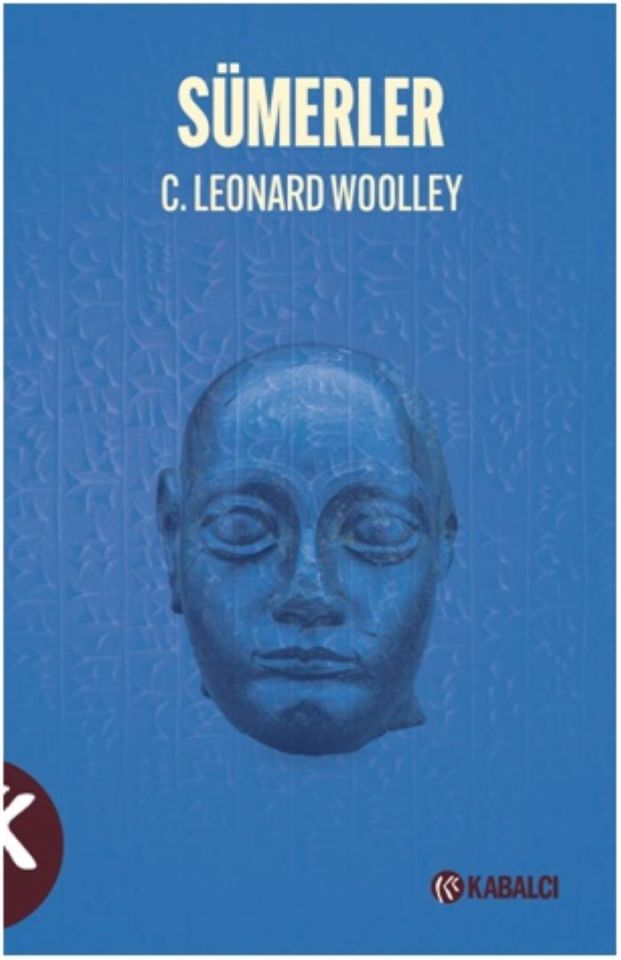
View On WordPress
0 notes
Text
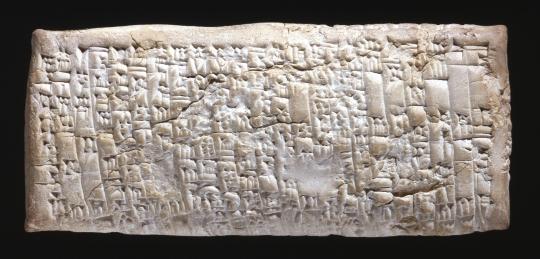
Behind the Meme: Complaint Tablet to Ea-nasir
In 1953, explorer Sir Leonard Woolley discovered and acquired the tablet from what is believed to be the ruins of Ea-nasir's home while on an expedition to the city of Ur. Several other similar tablets complaining about poor copper quality were also recovered, suggesting Ea-nasir frequently sent his customers poor-quality goods. The tablet is currently held at the British Museum.
A few of the most viral Tumblr posts about this meme:
https://probablybadrpgideas.tumblr.com/post/171826102481/your-players-are-faced-with-an-ancient-sumerian
https://brightwanderer.tumblr.com/post/645195882465230848/ea-nasir-is-that-you
Translation of the tablet:
Tell Ea-nasir: Nanni sends the following message:
When you came, you said to me as follows : "I will give Gimil-Sin (when he comes) fine quality copper ingots." You left then but you did not do what you promised me. You put ingots which were not good before my messenger (Sit-Sin) and said: "If you want to take them, take them; if you do not want to take them, go away!"
What do you take me for, that you treat somebody like me with such contempt? I have sent as messengers gentlemen like ourselves to collect the bag with my money (deposited with you) but you have treated me with contempt by sending them back to me empty-handed several times, and that through enemy territory. Is there anyone among the merchants who trade with Telmun who has treated me in this way? You alone treat my messenger with contempt! On account of that one (trifling) mina of silver which I owe(?) you, you feel free to speak in such a way, while I have given to the palace on your behalf 1,080 pounds of copper, and umi-abum has likewise given 1,080 pounds of copper, apart from what we both have had written on a sealed tablet to be kept in the temple of Samas.
How have you treated me for that copper? You have withheld my money bag from me in enemy territory; it is now up to you to restore (my money) to me in full.
Take cognizance that (from now on) I will not accept here any copper from you that is not of fine quality. I shall (from now on) select and take the ingots individually in my own yard, and I shall exercise against you my right of rejection because you have treated me with contempt.
Source: https://knowyourmeme.com/memes/complaint-tablet-to-ea-nasir
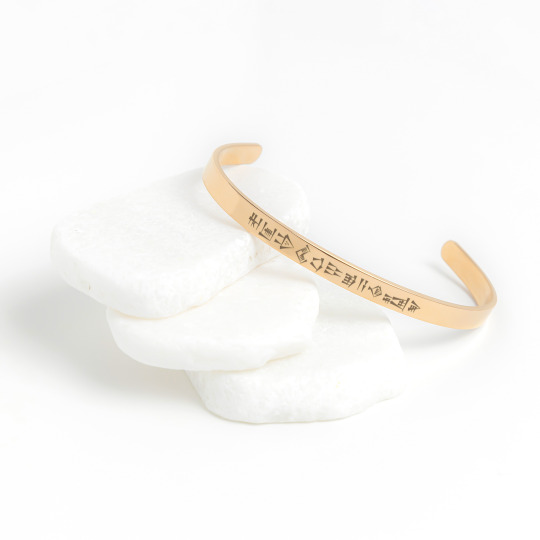
6K notes
·
View notes
Text
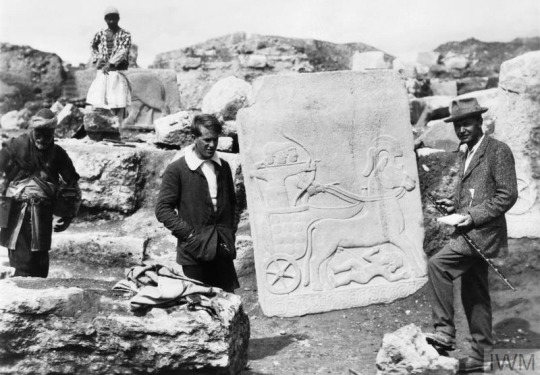
T E Lawrence with Leonard Woolley, the archaeological director, with a Hittite slab on the excavation site at Carchemish near Aleppo before the First World War.
20 notes
·
View notes
Photo
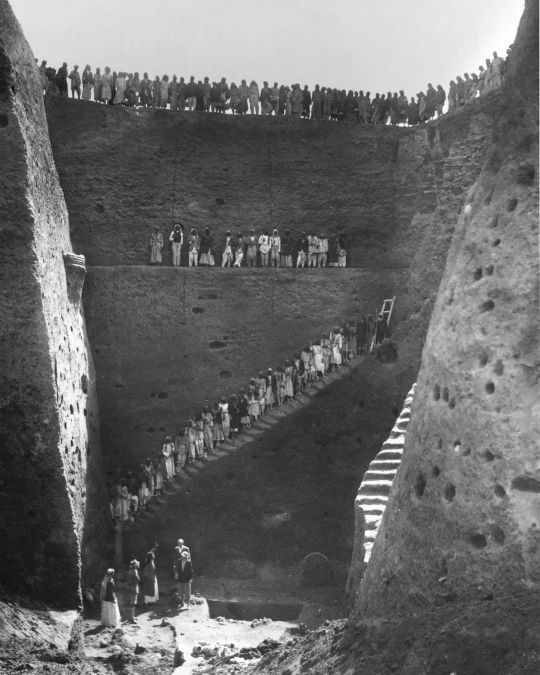
Southern Mesopotamia (modern Iraq). Excavation of the Royal tombs of Ur, 1920s. The Ur site excavated by C. Leonard Woolley and his team contained about 1800 burials. Woolley classified 16 of these as “royal” based on their distinctive form, their wealth, and the fact that they contained burials of servants and other high-ranking personages along with the “royal” person. https://www.instagram.com/p/CkTsoAjNqC_/?igshid=NGJjMDIxMWI=
255 notes
·
View notes
Text

“It belongs in a museum.” With these words, Indiana Jones, the world’s best-known fictional archaeologist, articulated an association between archaeologists, antiquities, and museums that has a very long history. Indeed, even Jones himself would likely marvel at the historic setting of the world’s first “museum,” and the remarkable woman who is believed to have been its curator, the Mesopotamian princess, Ennigaldi-Nanna.
Ennigaldi-Nanna was the priestess of the moon deity Sin, and the daughter of the Neo-Babylonian king, Nabonidus. In the ancient Mesopotamian city of Ur, around 530BCE, a small collection of antiquities was gathered, with Ennigaldi-Nanna working to arrange and label the varied artefacts.
This collection was considered by the British archaeologist, Sir Charles Leonard Woolley, to be the earliest known example of a “museum”.
20 notes
·
View notes
Text

Leonard Rosoman OBE, RA (1913-2012)
The American Rabbit
Signed and dated 1978
Gouache
Woolley and Wallis
58 notes
·
View notes
Text
37 Lost Books on Ancient Mesopotamia
The Lost Book Project is charging $12 for this collection. If you found this roundup useful, please consider donating to the Internet Archive instead.
The Epic of Gilgamesh by A. George (1999)
Enuma Elish: The Seven Tablets of Creation by L. W. King (1900)
Ancient Iraq by G. Roux (1964)
History Begins at Sumer: Thirty-Nine Firsts by S. Kramer (1956)
The Code of Hammurabi by Hammurabi (1905)
The Sumerians: Their History, Culture, and Character by S. Kramer (1963)
Ancient Mesopotamia: Portrait of a Dead Civilization by L. Oppenheim (1964)
The Ancient Near East - An Anthology of Texts and Pictures by J. Pritchard (1958)
Babylonian Magic and Sorcery by L. W. King (1896)
The Sumerians by C. Leonard Woolley (1920)
The Religions of Ancient Egypt and Babylonia by A.H Sayce (1901)
Babylonian and Assyrian laws, Contracts and Letters by C. H. W. Johns (1904)
The Richest Man in Babylon by G.S Clayson (1926)
A history of the Babylonians and Assyrians (2nd Edition) - G. S. Goodspeed (1902)
Assyria, its Princes, Priests, and People - A. Sayce (1885)
The teachings of Zoroaster, and the philosophy of the Parsi religion by S. A. Kapadia (1913)
An old Babylonian Version of the Gilgamesh Epic by M. Jastrow (1920)
Assyrian and Babylonian Religious Texts; Prayers, Oracles, Hymns. Copied from the original tablets by J. A. Craig (1895)
Babylonian and Assyrian literature - comprising the epic of Izdubar, hymns, tablets, and cuneiform inscriptions - E. Wilson (1901)
Babylonian Boundary Stones and Memorial Tablets in the British Museum Vol. 1 by L. W. King (1912)
Babylonian Boundary Stones and Memorial Tablets in the British Museum Vol. 2 by L. W. King (1912)
Chaldean Account of Genesis - Containing the Description of the Creation, the fall of man, the deluge, the tower of Babel, the times of the patriarchs, and Nimrod - G. Smith (1876)
Cuneiform Parallels to the Old Testament by R. W. Rogers (1912)
Discoveries Among the Ruins of Nineveh and Babylon - A. Layard (1853)
Myths & Legends of Babylonia & Assyria - L. Spence (1916)
Myths of Babylonia and Assyria by D. A. Mackenzie (1915)
The Babylonian Legends Of Creation by E. A. Wallis-Budge (1921)
The Chaldean Account Of The Deluge by G. Smith (1873)
The Code of Hammurabi by P. Handcock (1920)
The Code of Hammurabi, King of Babylon about 2250 B.C. by R. F. Harper (1904)
The Devils and Evil Spirits of Babylonia Vol. 1/2 (1903)
The Law of Hammurabi and Moses; a sketch by H. Grimme (1907)
The Religions of ancient Egypt and Babylonia - A. Sayce (1902)
Reports of Magicians and Astrologers of Nineveh and Babylon in the British Museum - Vol 1 - R. Thompson (1902)
Reports of Magicians and Astrologers of Nineveh and Babylon in the British Museum - Vol 2 - R. Thompson (1902)
6 notes
·
View notes
Text
Durante las excavaciones de Ur llevadas a cabo por Sir Charles Leonard Woolley entre los años 1922 y 1934, cualquier entierro sin cámara funeraria recibía el nombre de ‘fosa de la muerte’ (eran conocidas también como ‘fosas funerarias’).
2 notes
·
View notes
Text

Thomas Edward Lawrence, later also known as “Lawrence of Arabia”, and the archaeologist Charles Leonard Woolley in Syria, 1913.
26 notes
·
View notes
Text

El arqueólogo británico Leonard Woolley y su esposa Catherine en el momento del descubrimiento de tuberías en cerámica que se utilizaron como red de alcantarillado y aguas de lluvia en lo que se considera el primer sistema de drenaje de agua de la historia y data de antes del año 4000 A. C. Ciudad de Ur (Mesopotamia) en 1930
12 notes
·
View notes
Text
Charles Leonard Woolley – Sümer Sanatının Gelişimi (2022)
İlk “modern” arkeologlardan biri olarak kabul edilen ve özellikle Mezopotamya’da Ur’daki kazılarıyla tanınan Charles Leonard Woolley, Sümer sanatının gelişimini, Sümer tarihinin inişli çıkışlı dönemleriyle ilişkilendiriyor ve belirleyici siyasi olayları okuyucuya aktarıyor.
Konuya ait kaynakların neler olduğunu göstererek ilgili tarihsel gelişmenin izini sürüyor.
Büyük olasılıkla yaşayan…

View On WordPress
0 notes
Text
For some, the 1920s were an exciting time to be alive. The Great War had just ended in 1918, and some countries were enjoying economic boom, allowing their citizens to indulge in lavish and decadent lifestyles. In the field of archaeology, sensational discoveries were being made, including the find of Tutaankhamun’s tomb by Howard Carter, and the excavation of the city of Ur by Leonard Woolley, both in 1922.
38 notes
·
View notes
Text
youtube
Lament for Gilgamesh, performed by Peter Pringle on a reconstruction of the Gold Lyre of Ur
From the video description:
This video is a performance of a Sumerian incantation and lament upon the death of the hero, GILGAMESH. For those who are interested, the translation and transliteration of the Sumerian cuneiform tablets can be found online at the University of Oxford website - The Electronic Text Corpus Of Sumerian Literature.
“The Gold Lyre of Ur” was unearthed by archaeologist, Sir Leonard Woolley, in the 1920’s during his excavations in the Sumerian city of Ur, in modern day Iraq. Unfortunately, as you can see from the photo at the top of the video, there was little left of the lyre because the Sumerians simply put it into the ground 5000 years ago and covered it over with tons of earth. In the intervening millennia, everything that was degradable turned to dust, and only the imprint of the instrument was left, along with the stone mosaic decorations, the four vignettes made of shell, and the gold.
Thanks to very careful measurements and photos taken by Woolley, museum curators have been able to reconstruct the fragile bits and pieces, and the instrument is now on display in Baghdad. What you see in this video is my own replica, made from cedar like the original. Needless to say, I used brass sheeting instead of gold, but it is unlikely that the ornamentation would change the basic sound of the instrument.
A lyre of this size, whose lowest note is the same as the lowest ‘C’ on a piano keyboard, would probably have been used as a drone instrument, and would not have been used to play melodies like a harp or a smaller lyre. The bench-shaped bridges used on these instruments, suggest that they probably “buzzed” like the modern Indian tamboura, or the Ethiopian “begena” lyre. The buzzing sound made possible by the wide flat bridge, greatly increases the volume output of the string, as well as the decay time of the vibration.
The large “balag” drum you see on my left in the video, is four feet (120 cm) in diameter, and was a common percussion instrument in Sumer, although there are none that have survived the ages. These drums were an integral part of ceremonies to summon the souls in the “Netherworld” because, as you can hear, they make enough noise “to wake the dead”! The belief in an afterlife was an integral part of Sumerian culture, and I highly recommend Dr. Irving Finkel’s wonderful book on the subject, THE FIRST GHOSTS.
The video of my full performance was too long, so I have edited it down to about 8 minutes (still too long IMO). Much of this sort of incantation was repetition, but I suspect the ancient Sumerians had a greater tolerance for long, drawn-out rituals than most of us do today. I chopped several minutes out of the middle.
We have the Sumerian cuneiform texts, as well as some of the musical instruments, but we do not have the melodies because the Sumerians didn’t write them down. I believe that the parts that were sung were probably largely improvised, just as they are today in the Middle East and the Indian subcontinent. Ancient Sumerian teachers did not write down their music because they taught mainly by memory and by ear.
From the standpoint of a singer, I have performed these texts in a loud, declarative style. The Sumerians did not have amplification, and singers had to be heard by large crowds at temple gatherings, or sometimes outside.
2 notes
·
View notes
Text
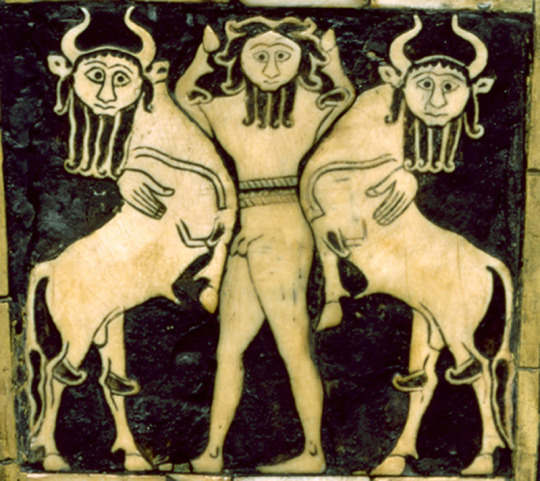
Top panel from the Bull-Headed Lyre of Ur, 2550–2450 BCE, now at the Penn Museum, Philadelphia (Object Number B17694B)
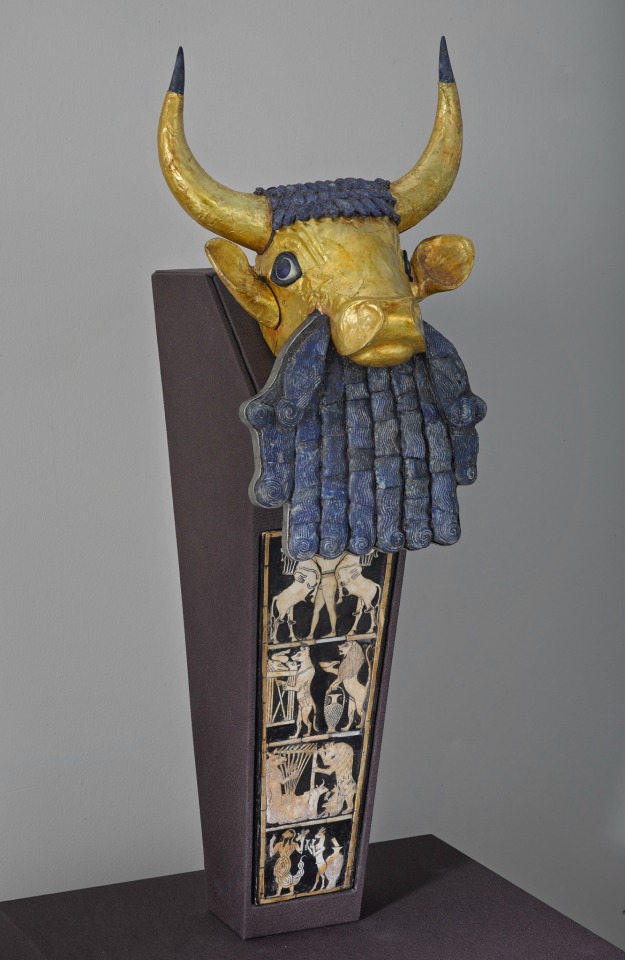
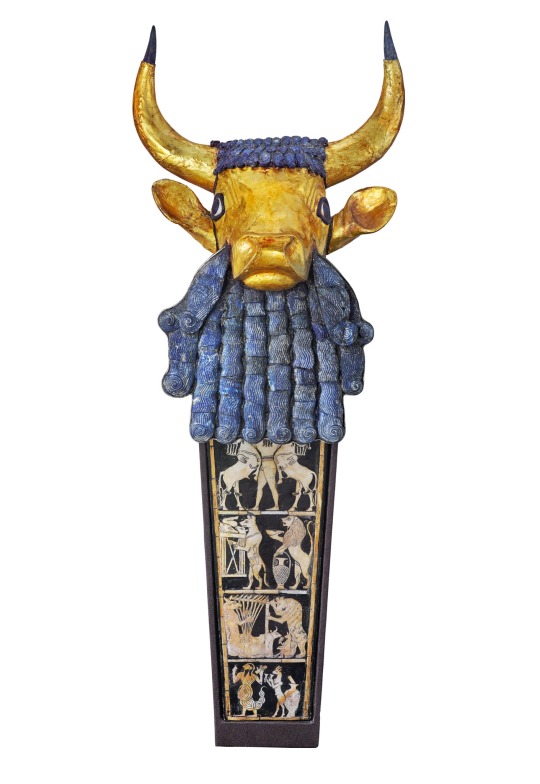
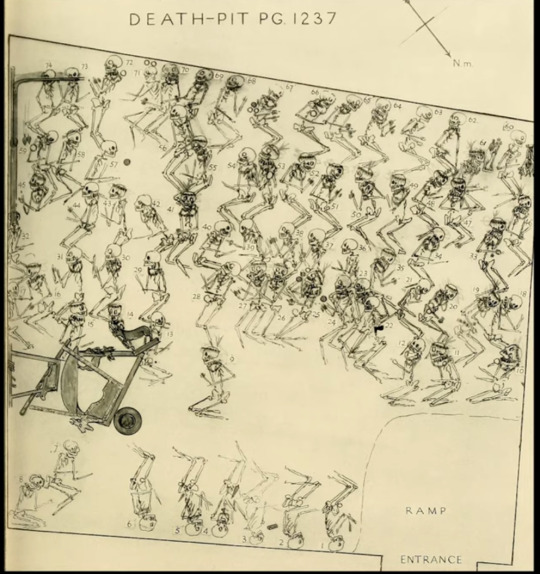
“THE BODIES IN POSITION IN THE GREAT DEATH-PIT PG/1237,” diagram showing the site where the lyre was found in the Royal Cemetery of Ur, from the report by C. Leonard Woolley.
0 notes